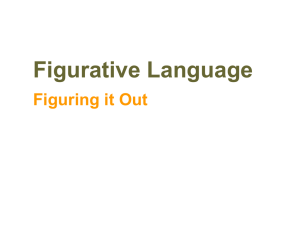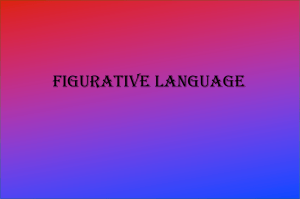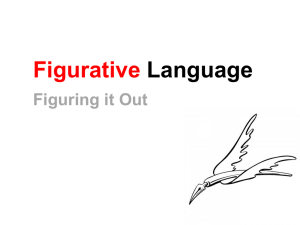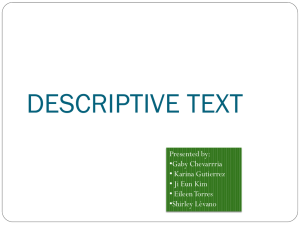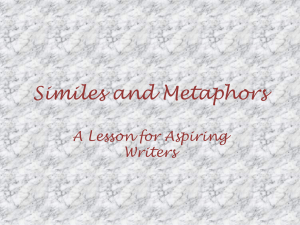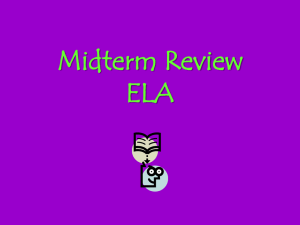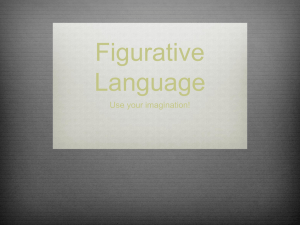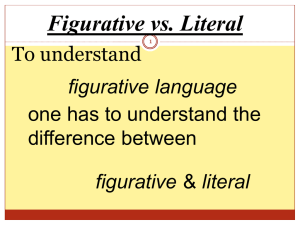Identifying and Interpreting Similes
advertisement
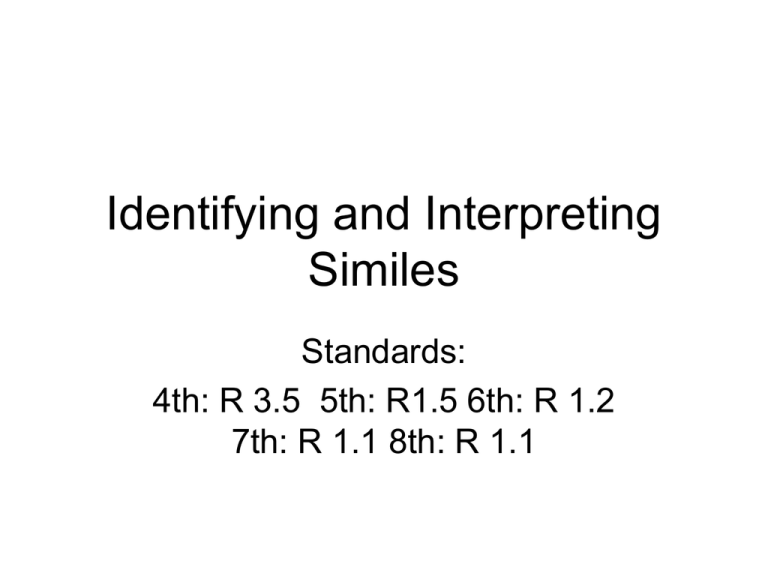
Identifying and Interpreting Similes Standards: 4th: R 3.5 5th: R1.5 6th: R 1.2 7th: R 1.1 8th: R 1.1 Learning Objective • Today we will identify1 and interpret2 similes. • • 1 find • What are we going to do today? P/S 2 make meaning from Compare these two pictures. Think about how they are alike. Pair-share with your partner. Write one (adjective) descriptive word on your whiteboard that describes both pictures. chili sun The chili and the sun are both___________. Today we will be using a specific kind of figurative language called similes. APK • A simile is a figure of speech that compares two unlike things using “like” or “as.” Example(s): Cold lemonade is as refreshing as a dip in the pool. Playing chess with Ashley is like trying to outsmart a computer. His temper was as explosive as a volcano. – Non-example: I like pizza. concept R-A-J • What is a simile? •Which is an example of a simile? –A. She’s as fast as lightning. –B. We like to play games. How did you know that? It’s important to identify and interpret similes because… • they make language more dramatic in fewer words. • they help you understand and appreciate poetry. • they help us to better understand or “see” what the author is saying. 45 What literary device is used lines 10–12 of “Sheepdog” • they are tested on the CST. in(“When the Shepherd’s whistle / Which reason is most important to you? You can give me one of my reasons or one of your own. P/S releases her, / she’s off, like an arrow, running east. . .”)? A metaphor B simile C symbol D pun Steps to identify and interpret similes: • 1. Read the sentence(s) • 2. Identify and underline what is being compared. • 3. Identify the type of figurative language: – If “like” or “as” is used = simile • 4. Interpret using textual clues. She listens to the teacher and always seems to have the answers. Karen has a mind trap. _____ like a steel ___________ • 1. Read the sentence(s) • 2. Identify and underline what is being compared. • 3. Identify the type of figurative language: – If “like” or “as” is used = simile • 4. Interpret using textual clues. Interpretation: She remembers everything. Skill/guided practice “I do” CFU: How did I identify the simile? P/S How did I interpret the simile? P/S The President and his wife arrived at the formal celebration. Her evening ___________ gown ______ sparkled like a diamond. • 1. Read the sentence(s) • 2. Identify and underline what is being compared. • 3. Identify the type of figurative language: – If “like” or “as” is used = simile • 4. Interpret the simile using textual clues. Interpretation: Her gown was beautiful. CFU: How did we identify the simile? P/S How did we interpret the simile? P/S Skill/Guided Practice “We do” The baby was like an octopus, ____ ___________ _ grabbing at all the cans on the grocery store shelves. • 1. Read the sentence(s) • 2. Identify and underline what is being compared. • 3. Identify the type of figurative language: – If “like” or “as” is used = simile • 4. Interpret using textual clues. Interpretation: The baby was misbehaving. Skill/Guided “You do” CFU: How did you identify the simile? P/S How did you interpret the simile? P/S Extra Guided Practice… Paul Bunyan was huge. His feet were as big as boats. It is said that when Paul walked, his footprints formed the Great Lakes. Those girls are like two peas in a pod. They play together at every recess, and often dress the same at school. Closure • What is a figure of speech that compares two unlike things using like or as? • Why is it important to identify and interpret similes? I walked along the beach and listened to the ocean. My ___________ sadness ________ was as unending as the waves. • 1. Read the sentence(s) • 2. Identify and underline what is being compared. • 3. Identify the type of figurative language: – If “like” or “as” is used = simile • 4. Interpret using textual clues. My interpretation is______________________. Closure: Skill check Independent practice • Directions: Read the sentences. Identify the simile and underline what is being compared. Interpret using textual clues.

